| |
|
|
| |
Low and Clear.
Wed 10th October, 2018
|
|
|
|
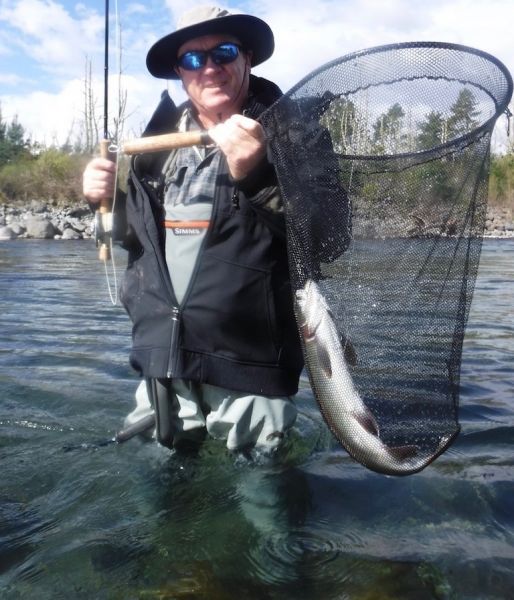 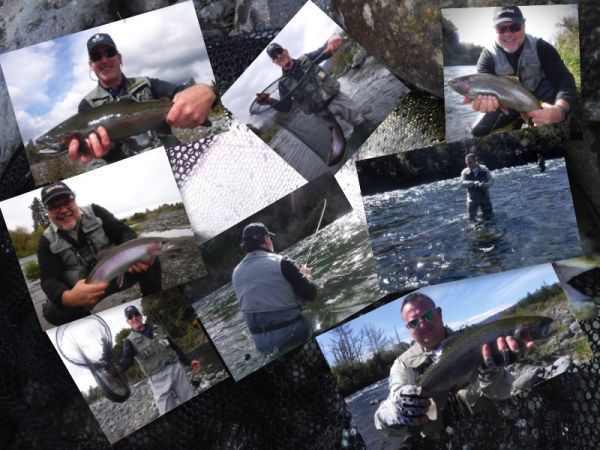 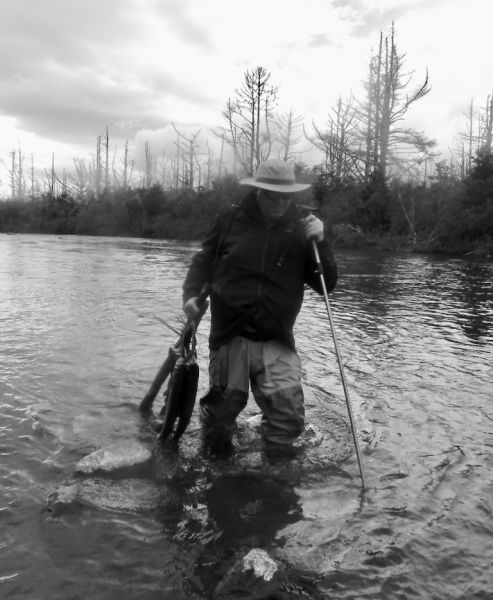
Apologies for the late posting but I've been tied up with some friends of mine. All of them have fished the Tongariro before but Rich, Charles and Grant hadn't been on the river for a couple of years and were keen to catch up on the changes. Alan gets over more often than the others and was here just a few months ago so knows his way around without too much input from me.
They're a pretty lucky bunch and usually do ok and it was no exception this time because they all caught fish.
They did well on the middle and upper river and stretches around Duchess and Big Bend were particularly kind to them.
Big Bend has been pretty consistent for the past few weeks and its been rare to find the small car-park empty lately.
As you'd expect now the tail-end of the pool is full of spawning rainbows but the rest of it has been throwing up some much better fish.
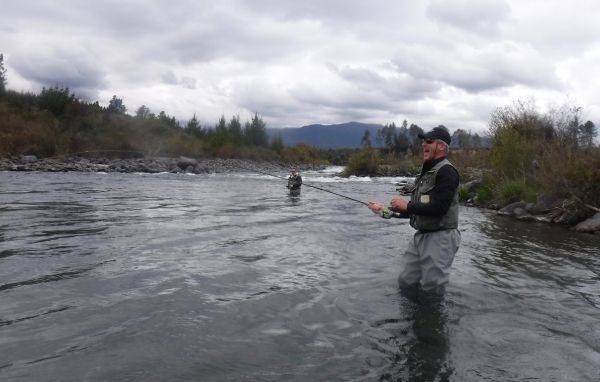 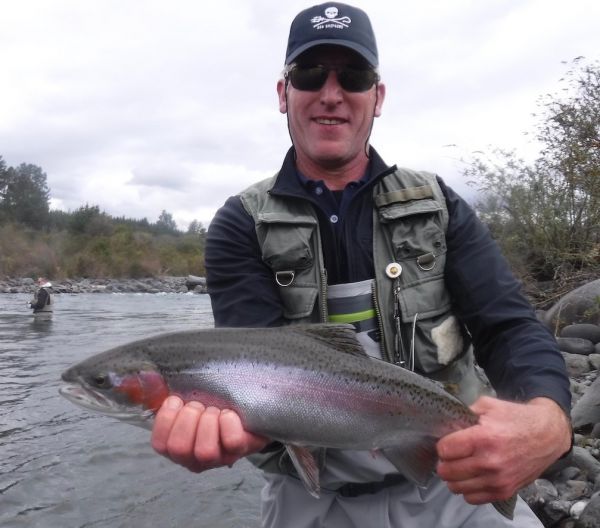
Grant had a lot of fun in the head of the pool and picked up a couple of nice fish.
He was even more pleased with himself because Charles {in the background} had only just fished the same spot without a touch.
To add insult to injury just after this pic was taken they swopped places again and first cast he landed another four pounder.
With flows in the low twenties, wading is the easiest I've seen it here for quite some time and you can get at all the likely spots without too much difficulty. An added bonus is the crossing to the TRB is also pretty simple if you fancy heading down to the Fan or upriver to Boulder.
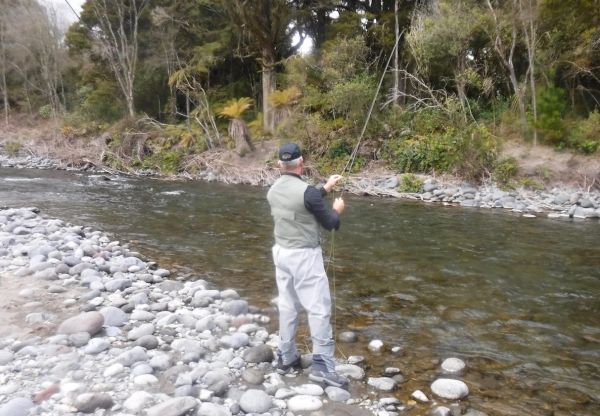
For most of the winter and the early part of spring the flow graph was seldom below thirty cumecs. But when the Tongariro is low and clear like this its imperative you change the way you approach a day on the river...if you don't, then you're going to find it hard going. In these low, clear conditions trout feel exposed and are understandably more wary of everything. Personally I rarely use the traditional indicator set up when its like this ... unless I'm fishing a deeper pool.
With milder temperatures triggering an increase in insect activity trout are already beginning to look up for their food. The past couple of weeks has seen mayfly hatching most days especially when its been overcast with light rain or drizzle. These are perfect conditions for mayfly nymphs to emerge.
As they ascend to the surface and transform into the dun {posh name sub imago} their mouth parts harden and cease to function. This means they're no longer able to feed or drink. Drizzly weather decreases the chances of dehydration ensuring they survive long enough to mate. And you'll often see bigger hatches on damp overcast days.
Although its still early doors a couple of people have told me they've had the odd fish on small dry flies recently. And I'm definitely getting more fish on the dry and dropper rig since the last report.
Now is the time to lighten things up a bit ... and lower breaking strain leader and tippet is always a good start.
These lines are much stronger and more reliable than they used to be and if you also go down a rod weight or two this will help protect the hook hold and lighter tippet from any sudden lunges or unexpected runs while playing a fish.
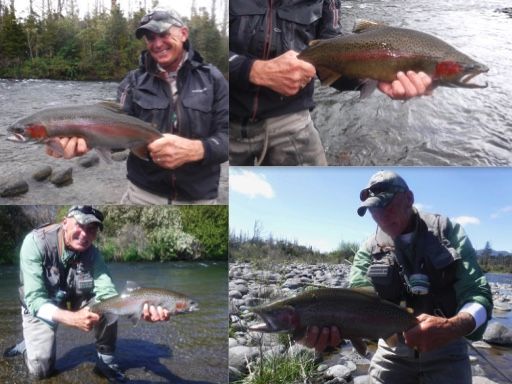 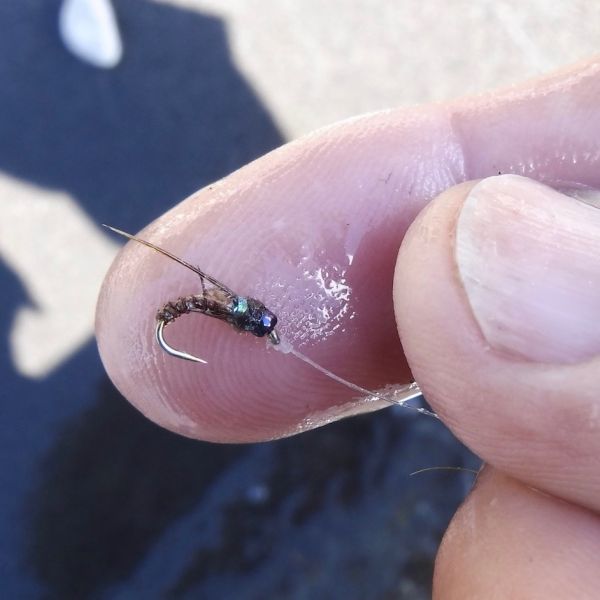
Try smaller nymphs now as well.
A lot of the fish I've been getting lately have taken size 16's with Quasimodo's, Flash-back Hare and Copper's and The Little Brown Bug all taking fish.
You'll notice all these patterns are tied with a little bit of bling. Which the experts tell us trout mistake for the tiny gas bubble that many species of mayfly and caddis generate to help the nymphs or pupa rise through the water column in their bid to reach the surface.
Dry and dropper set-ups better imitate this and in the present conditions are less likely to spook already wary fish.
Its also important now to take your time and slow everything down a bit. Approach a likely looking spot cautiously. Avoid sudden movements and be aware of shadows caused by yourself and tackle. Sound travels fast in these conditions so if you have to get in the water wade carefully or you'll blow your chances before you even get into position.
Fishing runs or riffles is a good option in low water conditions because the disturbed water at the surface makes it more difficult for predators to spot fish ... and the fish know it.
In saying that, its not impossible to see them ... and providing you don't rush and thoroughly polaroid the area first, you soon get used to spotting the dark "smudges" holding in this type of water.
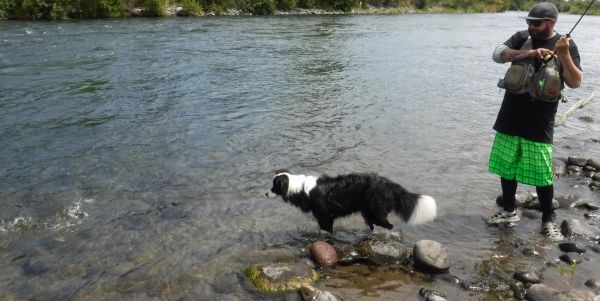
Drab clothing is another thing thats often recommended when trout fishing in these testing conditions.
Although I often wonder about this, after seeing "Osama" from Sporting Life catch fish wearing this almost invisible ensemble back in January 2017. Its the only time I've ever seen a rainbow come out of the river wearing sunglasses!
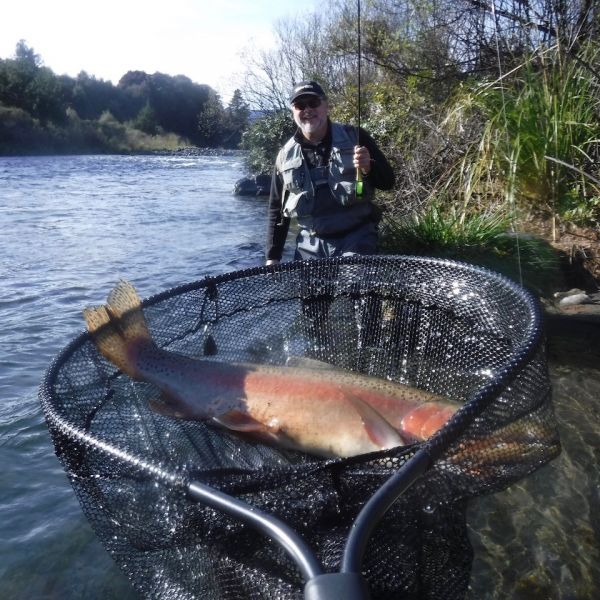 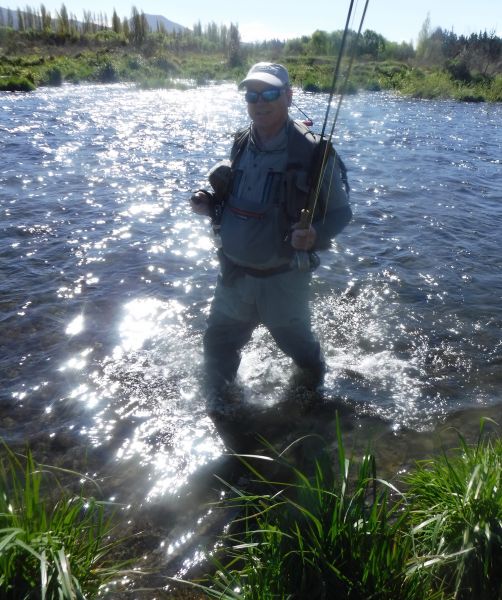
A lot of jacks in the river at present...some a lot better than others.
Alan and I finished the day in the Braids yesterday and the whole place was chokka with spawning rainbows.
Its the same story throughout the river.
But because they're so easily spotted they get a lot of attention from anglers desperate to catch something in the difficult conditions ... and as a result they're very, very skittish.
Trying fast runs is often a better option and we've had some fun sport Euro nymphing with small flies on the drop shot rig. Alan has been keen to practise this technique all week because when he gets back to Oz he wants to try it in an estuary near his home where he targets Blackfish.
Which put a smile on Grantly's face because yet another Czech nymph outfit went out the door.
Now for that knot I use to join the end of the leader to the Euro nymph line. I only know this as a "Spider Knot" not to be confused with the "Spider Hitch Knot" which has an entirely different application. We used to use this back in Wales in my surfcasting days to connect the 80 Ib breaking strain shock leader to the much thinner main line and its never let me down ... then or now. If you know it as some other name please let me know.
THE SPIDER KNOT
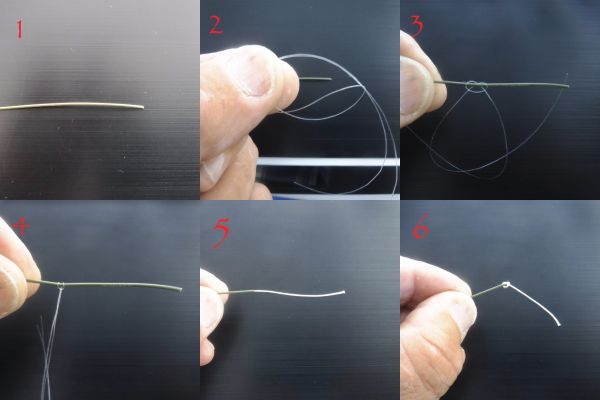
STEP 1
If the fly line comes with a factory welded loop ... cut it off.
STEP 2
Take a 12 inch length of 8 lb bs mono and double it, then form a loop as shown.
STEP 3
Place over the fly line and part tighten.
Step 4
Pull and tighten further until the mono cuts into the fly line coating.
STEP 5
Grip the fly line tight in one hand and with the other pull the mono quickly with the other towards the cut end to strip off the outer coating.
STEP 6
Form an overhand knot with the exposed core and try and keep it next to the remaining fly line.
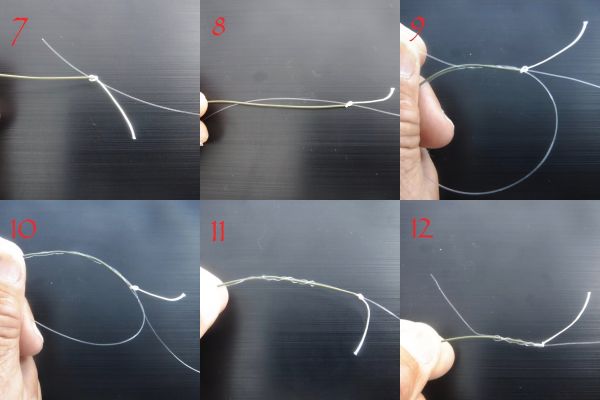 STEP 7 STEP 7
Place the leader through the overhand knot.
STEP 8
Pull about a foot through so that its behind the fly line.
STEP 9
Pull the tag around and to the front and begin the first of four turns around the the fly line and mono.
Step 10
Complete the four turns.
Step 11
Tighten the braid knot and the mono knot and moisten the line. Grip both lines tightly and pull slowly until the two knots meet. Make sure the barrel of the four turn knot butts properly against the other.
STEP 12
Grip both tags with teeth or pliers and tighten hard. Then pull both lines simultaneously and really snug things up.
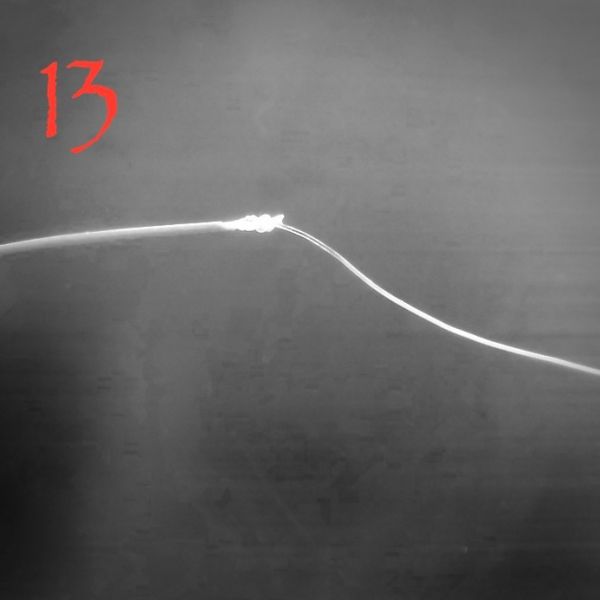
Trim the tag ends close. Then apply a drop of UV resin and form a tear drop shape before setting it with the torch. This join gives you a much smoother transition from fly line to leader. And is less troublesome when it runs through the guides during those longer casts.
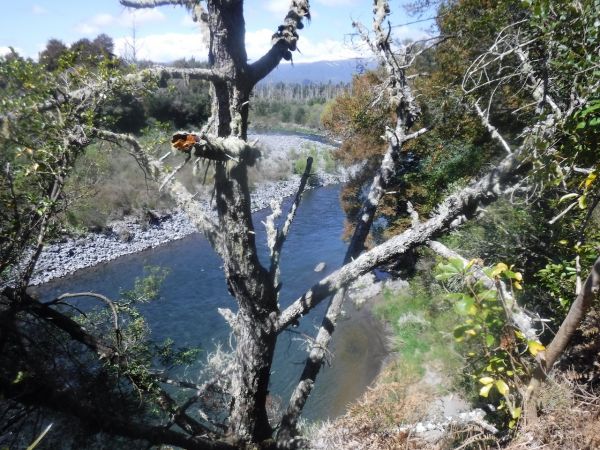
So all in all a pretty good week on the Tongariro and not as busy as I'd expected. In fact, considering its school holidays I think I've only set the alarm once and when I got to the river quickly realised I could fish "gentlemen's hours" for the rest of the week.
A lot of anglers struggle in the present conditions ... and as we head towards summer they often give up on the Tongariro altogether.
But its a well used cliché that "the summer fishing on the Tongariro is its worst kept secret" ... and they're right.
With less angling pressure, the first of "this seasons" browns are not far away and with the chance of a bit of dry fly fishing as well, its a great time to be on the river.
The settled weather we've enjoyed the last few days is set to change by tomorrow and already the wind is picking up and the sky is filling with cloud. A bit of a mixed bag for the remainder of the week with a cold snap bringing more snow to higher ground and rainfall everywhere else. However, things are forecast to warm up again next week.
Actually some "good rain" wouldn't go amiss at the moment, but that doesn't look likely at present.
Freshies are still trickling through and there's plenty of spawning and recovering fish in the Tongariro.
From now on you'll come across more and more of this years casualties along the river because not all of them make it back to the lake. Its not easy out there but if you change tactics to combat the low clear conditions you'll do ok.
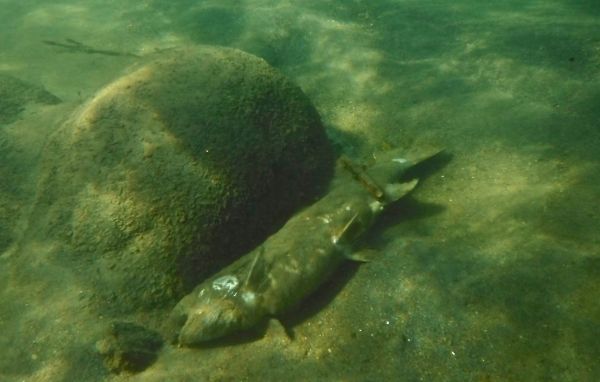
Enjoy the challenge guys
Tight lines
Mike |
|
|
| Back to Top |
|
|
|
|
|
|
|